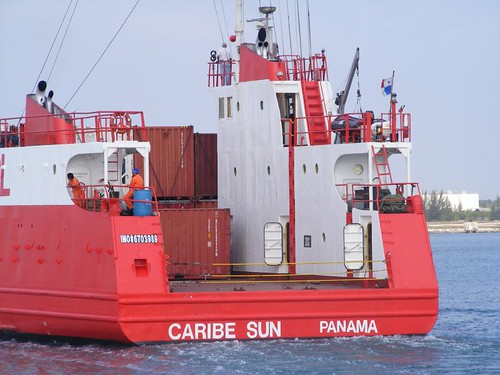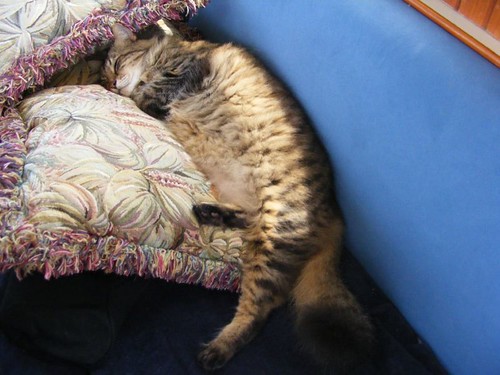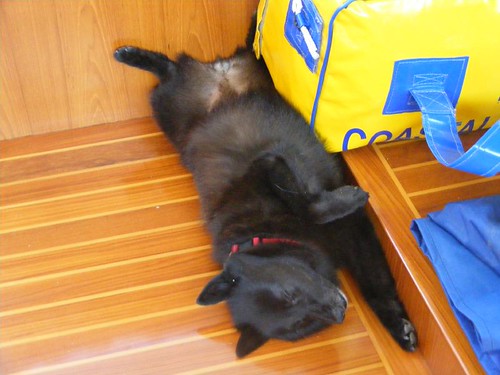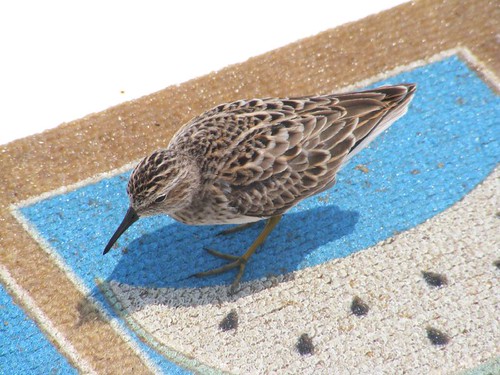May 10-13, 2011
This was the small, inbound freighter we passed in Ft. Pierce inlet at 9:30 a.m. on
May 10, 2011 as we were heading out to sea. A trip ending for that crew and just beginning for the FLUKE crew. Right outside the inlet we rendezvoused with 6 other Krogens, ranging in size from 39 – 48' in length. We had agreed to travel in a group all the way to Beaufort, NC. The trip would take 3 nights and 4 days at sea, weather permitting.
This plan would enable us to better our previous 2 nights at sea to 3 nights. Plus, we would be traveling with a group of other boats for the first time. Prior to the rendezvous outside the inlet, we had had 2 meetings with the group to understand what the expectations and “rules” would be for the “fleet”. Some of the cruisers had no experience traveling offshore over night, so being able to travel with other boats would help give them confidence and a better sense of security for the night travel; the plan was called “Cruising With Confidence”. All boats would check in with the lead boat via VHF radio every 6 hours; plus you could call anyone else in between if you had questions or comments about anything going on.
The FLUKE crew seemed to be handicapped from the beginning. We were dead tired from having to work long days and nights for a straight week to get the boat and house in mostly proper order so that we could be gone for 6 months. When we left the dock at 7:00 a.m. every cabin had several totes filled with gear for the trip. Two of us worked for 2 more hours unpacking and stowing some of those items during the trip to the inlet. Eddie said this was the worst level of preparation we have ever had, but his memory is very short term when it comes to events like that. The NOW is always the worst for him!
If we and FLUKE can hold together we will be traveling up the Hudson River, through the Erie and Oswego Canals, into Lake Ontario and the Thousand Islands, and hopefully up to Ottawa and Montreal via the Rideau Canal and back into the U.S. via the Richlieu Canal into Lake Champlain and then back into the Hudson River. After that our goal is to be back in the Chesapeake by the end of September for the annual Krogen rendezvous in Solomons, MD.
This photo shows how the fleet appeared on radar, in the shape of an inverted V. FLUKE is in the bottom right position; we are 3 miles behind the lead boat and 1.5 miles from the boat in the far left corner. This formation is designed to keep the boats together and provide a big target for other boats to see at night. It is hoped that they will alter course to avoid our little fleet. In fact, one large freighter, the YORKTOWN EXPRESS did kindly alter his course when we encountered him outside of Charleston, SC.
Conditions for the first day at sea were relatively mild. Since the ocean was flat, we could see lots of turtles. I was able to troll and caught and released two tunny tuna. This bird (a type of sparrow I think) landed on the swim platform. I guess it was trying to get a rest from flying. It picked a wet, salty, very noisy spot with a lot of exhaust fumes – ugh! I need to tell you that taking photos while the boat is underway is not always easy, especially if what you're trying to take a picture of is also moving. Yet everyone always asks for pictures, so just bear with me on some of my shots.
For the night watches, my shift ran from dark up until 12:30 a.m. I listened to an audio book to help keep my attention sharper. Wayne took over until around 1:00 a.m. and then Eddie manned the helm from around 3:00 - 6:00 a.m. when Wayne took over again until I came back on around 7:30 a.m. They usually listened to music to try to keep awake. The guys were able to nap periodically during the day; I can never sleep when the sun is up, even if I'm in a dark room. So, I man the helm a lot of hours during the day when they are asleep.
By the middle of the first night, sea conditions began to deteriorate, not with high waves, but the seas became very choppy and disorganized, causing a lot of pounding with the boat. Eddie got sick at that point and stayed in a state of discomfort until the fourth morning. He doesn't even like to discuss his seasickness, so getting any photos of him at this time was totally out of the question! I couldn't do any more fishing because it would be too uncomfortable for everyone to have to slow the boat down to let me land the fish. It is very tiring and boring having to ride in those sea conditions. You can't do any reading and sleeping is fitful because of the erratic motion of the boat. Poor Visitor got sick too and had a difficult time trying to find a place of comfort.
Ursa is a true sea dog and just settled into a regular sleeping and eating routine; she never likes to miss a meal and stayed on her daily feeding schedule. With no land in sight (we ranged from 20 – 50 miles offshore), she couldn't get any land smells and “complain” about wanting to go ashore. She was content to be with her favorite sea pack members. She had sense enough to stick close to the lift raft in case there was an abandon ship emergency as evidenced by this photo.
Some activities, although not necessarily good, at least provided a change of pace and a diversion from uncomfortable seas. Off Jacksonville, FL we were contacted by Navy Warship 69. They had established a 10 mile radius around their ship for live firing practice which prohibited any other vessel from traveling within that radius. We had to alter our course by several miles and to make it more complicated, NW 69 kept moving, changing the no travel zone.
This least sandpiper, typically a shore bird, landed on the upper back deck and was looking for dead insects and other scraps. It spent a lot of time pecking at Ursa's pee mat. During one of my night watches a tern landed on the bow rail and kept me company for several hours. I was surprised how it could hold on since the bow was rocking so much.
On the morning of Friday the 13th I awoke to overcast skies but much, and very welcomed, calmer seas. The rattling chop was gone and the seas were just long, rolling swells that we could ride over and down again without having our bottom drop out. We were finally in the home stretch and were able to reach Beaufort, NC by around 2:00 p.m. It was a relief to see the inlet and pass through into the quiet waters of the Intracoastal Waterway. We said goodbye to our fleet mates who were all heading to the nearest marina for the night; we were going to go another 20 miles to drop the hook at one of our most-visited anchorages.
Although tired, and looking forward to a quiet anchorage, we declared the offshore voyage a success, both in time and fuel saved. Here are our summary statistics from the Vero Beach dock to our first anchorage:
Continuous hours underway: 85.5
Distance: 575 nautical miles/660 statute miles
Diesel fuel burned: 245 gals. (purchased for $3.87/gal.)
Average speed: 6.9 knots (8mph)
Sunday, May 22, 2011
Subscribe to:
Post Comments (Atom)














0 comments:
Post a Comment